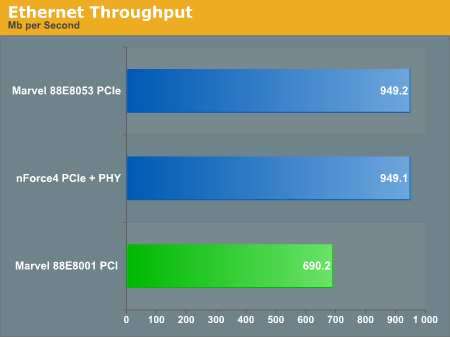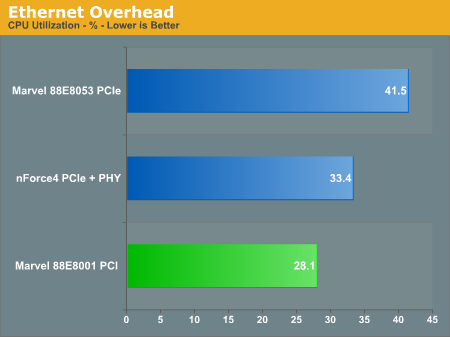nForce4 Ultra Roundup: Charting the Mainstream
by Wesley Fink on July 5, 2005 10:28 PM EST- Posted in
- Motherboards
Ethernet Performance
We have often talked about the throughput advantage of PCI Express compared to PCI and its impact on Gigabit LAN performance. To show you this, the new motherboard test suite includes LAN performance measurements.The Windows 2000 Driver Development Kit (DDK) includes a useful LAN testing utility called NTttcp. We used the NTttcp tool to test Ethernet throughput and the CPU utilization of the various Ethernet Controllers used on the nForce4 Ultra motherboards.
We set up one machine as the server; in this case, an Intel box with an Intel CSA Gigabit LAN connection. Intel CSA has a reputation for providing fast throughput and this seemed a reasonable choice to serve our Gigabit LAN clients. At the server side, we used the following Command Line as suggested by the VIA whitepaper on LAN testing:
Nttcps - m 4,0,On the client side (the motherboard under test), we used the following Command Line:-a 4 - l 256000 - n 30000
Nttcpr - m 4,0,At the conclusion of the test, we captured the throughput and CPU utilization figures from the client screen.-a 4 - l 256000 - n 30000


All Ethernet tests were performed with standard frames, but Gigabit Ethernet supports Jumbo frames as well. Jumbo frames will theoretically provide a further reduction in CPU overhead. We have seen test results that show the combination of Active Armor and Jumbo Frames can reduce CPU utilization below 10%, which is very respectable performance for on-chip gigabit LAN.










75 Comments
View All Comments
ChineseDemocracyGNR - Saturday, July 9, 2005 - link
"If you looking to save even more money, the 9NPA, based on the nForce4 x4 chipset, has a street price of around $90. You give up the SATA 2 support and 1000 bus, but most of the performance features are still available in the same basic motherboard. "I think you're talking about the 9NPAJ motherboard, which uses the nForce4 chipset and supports "2.0 GTs HT FSB".
truteck - Monday, December 19, 2005 - link
Regarding the post from ChineseDemocracyGNR on: Jul 9, 2005 3:19 PMQuoting statement from Anandtech's reviewer:
"If you looking to save even more money, the 9NPA, based on the nForce4 x4 chipset, has a street price of around $90. You give up the SATA 2 support and 1000 bus, but most of the performance features are still available in the same basic motherboard. "
-------------------
ChineseDemocracyGNR:
I think you're talking about the 9NPAJ motherboard, which uses the nForce4 chipset and supports "2.0 GTs HT FSB".
-------------------
I agree with ChineseDemocracyGNR! To AnandTech:
No disrespect intended!
"Sorry to say, but i believe your statement is wrong".
The Epox Model # EP-9NPA+Ultra MoBo does support Sata-2 drives.
I don't know where you got that incorrect info.
Also, i'm not sure what you are refering too about your other statement about "giving up 1000 bus"? It supports 2000 bus.
T_T
TheGlassman - Saturday, July 9, 2005 - link
HTT's multi's were listed in the review.I have confirmed that the Chaintech's 6-03 bios overclocks just fine with single core cpu's.
Phiro, I understand your point, and it is a good one.
For me Anandtech reviews are one of my primary tools for deciding what hardware to buy. I think it is the same for a lot of people. Anandtech has earned this trust. That is why this review is disturbing. The results do not match my experience. You might notice in my previous posts, that I have followed false trails trying to figure out why. I cannot explain why the Chaintech board (and others with experience with other boards) performed so poorly in overclocking.
The reason this is imoportant is that the final ratings follow the philosophy stated in the beginning, that a better overclocker is a better board, because the actual performance at stock speeds is equal.The application testing bore this out.
Us 'bleeding edge" guys are well aware of how very small changes can make a big difference in performance. The fact that the award winners were using bios's not available to the public ( I have just now rechecked) that are dated a few days after their most recent bios, (for dfi, a beta which carries no warrantee support, their last release bios (the one that will be on the board you buy) is dated in March), throws the final results into doubt. In other words they appear to be special bioses for this test.
In the past, Anandtech has been very forthcoming when using a beta bios, explaining why, and stating that the board maker will make it available, or the included features available in a release bios. This was not done, they were not even labeled as beta's.
When Anandtech labels a board as an award winner, it is giving it's seal of approval, that people such as your self and myself will factor in when making a buying decision. The truth is under your criteria, any of these boards will serve you very well. From the application tests, your decision should be based on a) a good match to your programs, b)features you need or think you may need, and c) price. Anandtech's recommendation is irrelevant.
Anandtech's "forum-bleeding edge" audience is larger than you assume in your estimate. The fact that you are looking at an nVidia board at all says you are very involved in you purchasing decisions, other wise you would let some one else handle it for you. "gimme something that works" would be your involvement.
Anand awards have been given to 2 boards that you cannot buy, or so far even upgrade, to "as tested".
Speaking for myself, computer hardware is hard to keep up with, and losing a rock like Anandtech will be a great loss. I hope that will not happen, but excellent sites do fall by the wayside if they slip too far.
Phiro - Friday, July 8, 2005 - link
I think Anandtech has their audience nailed down about 80% of the time - their one flaw is listening to their forums a little too much IMO.Too many people have posted "oh what a dumb review we already bought our motherboards blah blah blah" - a GOOD example of not listening to the forums. If you're posting on the forums, you've probably been here for some time and you're in that 1% of computer users who qualify as "bleeding edge". Anandtech doesn't want to constantly address just the bleeding edge audience - as fun as you can be, you're 1% of the market, and for every right decision you make, you make wrong decisions.
To rip on Anandtech a little bit though, they do listen too much to the forum overclockers. The vast majority of users have NO interest in overclocking. 4% higher framerates isn't worth goofing around with voltages and installing a water cooling system.
arswihart - Friday, July 8, 2005 - link
I think its funny that so many people are now like, "Epox is the best" "they OC the best" "I'm gonna get one of those Epox NF4 boards that Anandtech reviewed". I have told you for months that Epox is nice, and to get the 9npa+, and great reviews have been floating around for a long while now. someof you take Anandtech's word as the word of GOD. That is hilarious and I guess its to be expected out of the mainstream audience that reads Anandtech.About the 9npa+ and 9npa SLI, OFFICIAL dual-core BIOS's were just released today by Epox. Enjoy.
TheGlassman - Friday, July 8, 2005 - link
Good question. It could explain the problems experienced with most of the boards. The chipset will run well over 1000 with no problem, but 1200ish will cause the boards various problems, usually a reset to a safe mode.Peanya - Thursday, July 7, 2005 - link
Hmm I wonder if they tried a 3x LDT multiplier on some of those boards. I'm thinking that's why the Abit wouldn't get past 250MHz. I've not only seen reviewers get well past there, but many users. Some brands automatically lower the LDT for you, whereas some do not. Was this taken into consideration?AtaStrumf - Thursday, July 7, 2005 - link
MOBOs have always been messy things to test, debug etc. The thing I hate most is changing the MOBO, because there are so many possible problems associated with it.I do have one HUGE gripe with this roundup. You chose to test DFI's non SLI board as a control for SLI/Ultra boards, but that happens to be the worst possible choice. Why? Because, as you pointed out yourself, that is exactly THE SAME board, with just one pin on the chipset shorted/cut. For control you should have tested the worst case scenario, like a physically different board (just one PCIe 8x/different layout, feature set) possibly a newer revision. This brings us to the biggest problem with this kinds of assumptions and MOBO testing in general. Different versions, REVISIONS, bios', different memories, variable sample-to-sample MOBO quality, and now to top it off, different Athlon CPU revisions. I definately think you should not have made the assumptions that you did and should have tested ASUS, MSI and GIGABYTE NF4 Ultra boards. They are afterall one of the biggest enthusiast MOBO manufacturers.
If you want to keep your reputation you should definately pay more attention to this sort of things. Don't rush so much! You don't have do a roundup, post individual board reviews and take more time with them. Like you did with the DFI! You should even get at least three samples of each MOBO from different sources and compare them in order to really be able to get reliable results. Forum posts from other people can be very misleading, because of all the variables and skills these people have. This would make you THE BEST ;-) As things stand now, you're pretty mediocre I'm afraid.
One typo I found:
Page 19:
Our past tests have shown performance of the AGP-8x and PCIe **688** Ultra to be virtually identical
Probably 6800 ;-)
Viper4185 - Thursday, July 7, 2005 - link
1) Wesley next time please can you post instructions of how to run memtest to determine the best tRAS rating for your memory. I emailed you in your last article and received no response. Yes, I am a n00b. Perhaps someone else can tell me :P2) I have the same memory as you, how do I check if it is TCCD or TCC5?
3) You don't actually say which ethernet controller is better, the Marvell or the NVIDIA?
4) I think it was a big mistake for you to leave out the Gigabyte boards. For those that are interested in the Gigabyte boards compared to some of the above check out this review.
http://www.hardwarezone.com/articles/view.php?cid=...
Otherwise good review, thanks Wes. Hopefully you can answer Q1-3 or someone else :)
Jotequila - Thursday, July 7, 2005 - link
Hum.... Chaintech VNF4-Ultra can reach 275+ FSb easily, there are so many users here that can say same thing as me....There is something strange on the results, i can bet that other mobos on the round-up can reach high mhz too....
Look this:
http://img55.imageshack.us/img55/2891/superpi17hi....
Is with my chaintech, i think that you are cheating things here...
Best Regards,
Juan Edaurdo Donoso